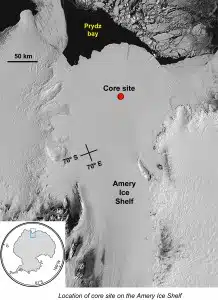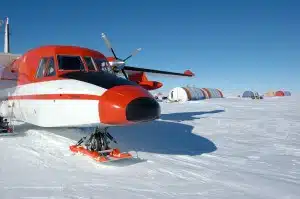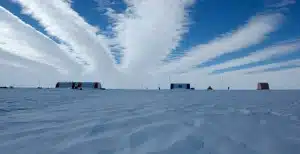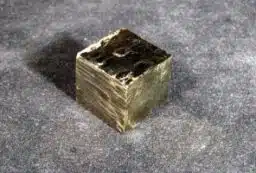
The community beneath the Amery Ice Shelf in Antarctica is 100 km from open water and hidden from view by ice half a kilometre thick. This ecosystem has developed very slowly over the past 9000 years, since the end of the last glaciation.
Today it is home to animals such as sponges and bryozoans fed by plankton carried in on the current.
During the summer of 2003-2004, six scientists and technicians from the Australian Antarctic Division (AAD) spent a month on the Amery Ice Shelf in east Antarctica and obtained sediment samples from beneath ice half a kilometre thick.
Researchers from Geoscience Australia, working in collaboration with the AAD, studied the sediment samples to determine their age and to look for clues to changes in the environment over time. When Geoscience Australia geologist Dr Alix Post studied the shell fossils within the core samples, she unexpectedly found evidence of ancient ecosystems.
“The last Ice Age peaked 18,000 years ago. At that time there would have been little or no life under the ice. This was the first core of geologically recent sediment ever collected beneath an ice shelf. By analysing sediment samples of the community, we were able to look at how species gradually replace each other over time,” says Alix.
“Our analysis of the fossils within the sediments shows that as the ice receded, the first animals reached this site 9000 years ago,” Alix says. “They were small mobile scavengers which would have been swept in via bottom currents from open waters, and were able to burrow and crawl for food.”
“In the following few thousand years, filter feeders, such as sponges and bryozoans colonised the area and were maintained by a constant supply of oxygen and food. This type of the species succession demonstrates the constant struggle for life beneath the ice shelf,” says Alix.
“Studying habitats such as these can help to improve our understanding about changes in species diversity over time, and allow us insight into how ecosystems are able to survive and prosper in such hostile environments. It could help us understand the potential effects of climate change on Antarctica,” she says.
Researchers from Hamilton College, New York, documented changes in another Antarctic ecosystem following the collapse of the Larsen B ice shelf in 2002.
The sediments Alix studied were collected by a team of scientists and technicians from the AAD, led by Ian Allison and Mike Craven.
Her work was published in History of benthic colonisation beneath the Amery Ice Shelf, East Antarctica. Marine Ecology Progress Series, 344 pp 29-37.
Alix Post is one of 15 early-career scientists presenting their research to the public for the first time thanks to Fresh Science, a national program sponsored by the Australian Government.
For further information, please contact the Geoscience Australia 24/7 Media Hotline 1800 882 035.
For Fresh Science contact: Sarah Brooker on 0413 332 489 and Niall Byrne on 0417 131 977 or niall@freshscience.org.
Further details at www.freshscience.org and at www.aad.gov.au/default.asp?casid=20367
Background information:
- Here is a link to the abstract for the paper on this work http://www.int-res.com/abstracts/meps/v344/p29-37/
- There’s also an article on the Antarctic Division website which highlights some of the inherent difficulties of working in the Antarctic http://www.aad.gov.au/default.asp?casid=14696









 Fresh Science is on hold for 2022. We will be back in 2023.
Fresh Science is on hold for 2022. We will be back in 2023.